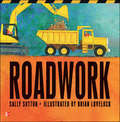- Table View
- List View
Why the Sea Is Salty: A Scandinavian Folktale [ELL Level, Grade 3]
by Lana Jones Alvaro FernandezNIMAC-sourced textbook
What Can You Do with a Paleta? (Elementary Core Reading)
by Carmen Tafolla Magaly MoralesNIMAC-sourced textbook
An Orange in January (Elementary Core Reading Ser.)
by Dianna Hutts Aston Julie MarenNIMAC-sourced textbook <P><P>An orange begins its life as a blossom where bees feast on the nectar, and reaches the end of its journey, bursting with the seasons inside it, in the hands of a child.
Waiting Out the Storm (Elementary Core Reading)
by Susan Gaber JoAnn Early MackenNIMAC-sourced textbook
ZooBorns!: Zoo Babies From Around The World (Elementary Core Reading)
by Andrew Bleiman Chris EastlandNIMAC-sourced textbook
Bear Snores On (Elementary Core Reading Ser.)
by Karma Wilson Jane ChapmanNIMAC-sourced textbook <P><P>On a cold winter night many animals gather to party in the cave of a sleeping bear, who then awakes and protests that he has missed the food and the fun.
When Daddy's Truck Picks Me Up (Elementary Core Reading #120)
by Carol Thompson Jana Novotny HunterNIMAC-sourced textbook
Bringing Down the Moon (Elementary Core Reading Ser.)
by Jonathan Emmett Vanessa CabbanNIMAC-sourced textbook <P><P>Mole is so taken with the beauty of the moon that he tries to get it from the sky, but eventually learns to appreciate it where it is.
Hen Hears Gossip (Elementary Core Reading Ser.)
by Megan McDonald Joung Un KimNIMAC-sourced textbook <P><P> Hen hears Pig whisper a secret to Cow ("Psst. Psst. Psst."), <P><P>and in no time at all Hen tells Duck ("Psst. Psst. Psst.") <P><P>who tells Goose ("Psst. Psst. Psst.") <P><P>who tells Turkey ("Psst. Psst. Psst.") <P><P>who tells Hen ("Psst. Psst. Psst.") <P><P>something not so nice about Hen herself. <P><P>"Whhaat?" <P><P>Hen is outraged. She's got to figure out who's behind the rumor. But will she discover even more than she bargained for?
Animals in the Park: An ABC Book [Big Book] (Elementary Core Reading Ser.)
by Bob BarnerNIMAC-sourced textbook <P><P>See what animals like to do in the park at night
The Big Book of Rhymes [Big Book] (Elementary Core Reading)
by McGraw-Hill Donald BearNIMAC-sourced textbook
McGraw-Hill Reading Wonders, Grade K, Your Turn: Practice Book
by Mcgraw-Hill EducationNIMAC-sourced textbook
























